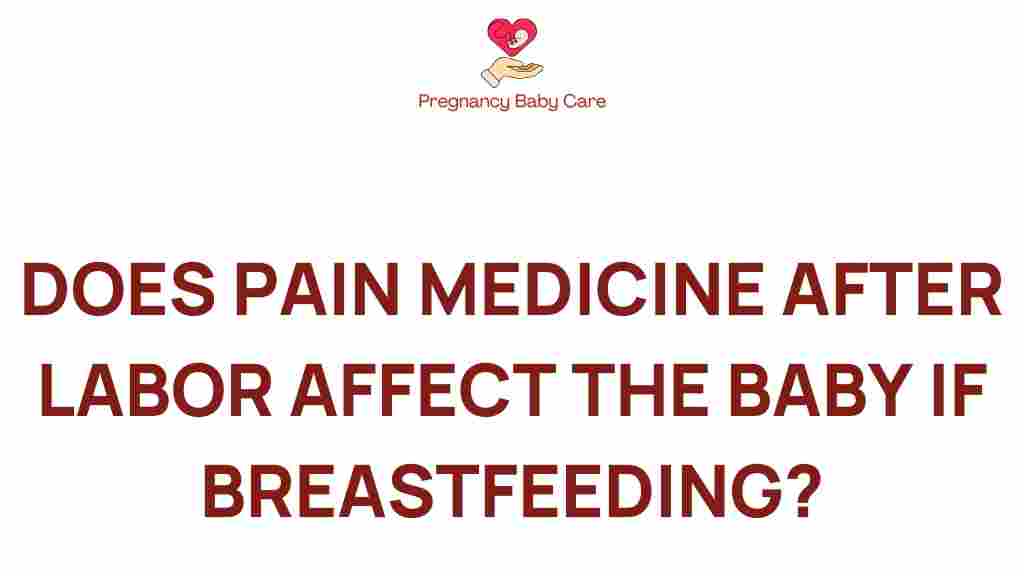The Surprising Truth About Pain Medicine, Breastfeeding, and Labor Recovery
Welcoming a new baby into the world brings immense joy, but it can also come with significant physical challenges for mothers. Labor and delivery can be intense experiences, leading to various levels of pain that often require effective management. Understanding the use of pain medicine during the postpartum period, especially for nursing mothers, is crucial for ensuring both maternal health and baby health. This article explores the complexities of pain management after labor, the safety of medications during breastfeeding, and best practices for postpartum care.
Understanding Pain After Labor
After labor, many women experience pain due to a variety of factors, including:
- Vaginal tears or episiotomy
- Uterine contractions as the body returns to its pre-pregnancy state
- Cesarean section recovery
- Physical strain from labor and delivery
Effective pain management is essential for new mothers to facilitate recovery and support their ability to care for their newborn. However, choosing the right pain medicine can be complicated, particularly for nursing mothers who are concerned about the potential effects of medications on their infants.
Types of Pain Medicine for Postpartum Recovery
In the postpartum period, several types of pain medicine may be recommended:
- Over-the-Counter (OTC) Medications: Non-steroidal anti-inflammatory drugs (NSAIDs) like ibuprofen or acetaminophen are commonly used for mild to moderate pain relief.
- Prescription Medications: In cases of severe pain, doctors may prescribe stronger medications, such as opioids. However, these should be used cautiously, especially among nursing mothers.
- Alternative Therapies: Some mothers may benefit from non-pharmaceutical options such as ice packs, heat therapy, or physical therapy.
The Safety of Pain Medicine During Breastfeeding
One of the primary concerns for nursing mothers when considering pain medicine is the potential impact on baby health. Many medications can pass into breast milk, which raises questions about their safety for infants.
What the Research Says
Research indicates that many common pain medications are generally considered safe for use during breastfeeding:
- Ibuprofen and Acetaminophen: These are both safe options for pain relief during breastfeeding, with minimal transfer into breast milk.
- Opioids: While some opioids can be used postpartum, they should be prescribed cautiously to avoid potential side effects in infants, such as sedation or respiratory issues.
- Topical Analgesics: Creams and patches that deliver medication locally may pose less risk to breastfeeding infants.
It is always advisable for nursing mothers to consult their healthcare provider to discuss the best options for postpartum care and pain management.
Factors Influencing Medication Effects
The effects of medication can vary based on several factors:
- Dosage: Higher doses may increase the risk of adverse effects.
- Timing: Taking medication immediately after breastfeeding might reduce the amount transferred to the baby.
- Individual Health Conditions: Pre-existing health conditions can affect how a mother metabolizes medication.
Steps for Safe Pain Management During Breastfeeding
Here’s a step-by-step guide for nursing mothers on how to manage pain safely and effectively:
Step 1: Consult Your Healthcare Provider
Before taking any medication, speak with your doctor or a lactation consultant. They can help you assess your pain levels and recommend safe medications.
Step 2: Choose the Right Medication
Opt for medications that are known to be safe during breastfeeding, such as:
- Ibuprofen
- Acetaminophen
Step 3: Monitor Your Baby
Keep an eye on your baby for any unusual behavior or symptoms, especially after taking new medication. Signs to watch for include:
- Excessive sleepiness
- Poor feeding
- Difficulty breathing
Step 4: Timing Your Doses
Consider timing your doses of pain medicine right after breastfeeding sessions. This can minimize the amount of medication present in your breast milk during the next feeding.
Step 5: Explore Alternative Pain Relief Options
If medications are causing concern, discuss alternative therapies with your healthcare provider. Options include:
- Physical therapy
- Massage therapy
- Acupuncture
Troubleshooting Pain Management Issues
Sometimes, nursing mothers may face challenges while managing pain post-labor. Here are some common issues and solutions:
Issue 1: Insufficient Pain Relief
If over-the-counter medications are not providing adequate relief:
- Consult your doctor about adjusting the dosage or switching to a different medication.
- Inquire about prescription options if necessary.
Issue 2: Adverse Reactions
If you notice any adverse reactions in your baby or yourself:
- Stop taking the medication immediately and contact your healthcare provider.
- Discuss alternative pain management strategies.
Issue 3: Anxiety About Medication Safety
It’s natural to feel anxious about the safety of medications while breastfeeding:
- Educate yourself about the specific medications you’re prescribed.
- Join support groups or forums for new mothers to share experiences and tips.
Conclusion
Managing pain after labor is an essential part of postpartum care that directly impacts maternal health and baby health. Understanding the options for pain medicine and their implications for nursing mothers is crucial. With careful consideration, proper consultation, and an awareness of medication effects, mothers can navigate the challenges of recovery while ensuring the safety of their infants.
For more information on postpartum care and safe medications during breastfeeding, visit this resource or check out the latest research at PubMed.
This article is in the category Health and created by PregnancyBabyCare Team
